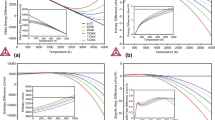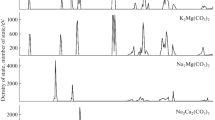Abstract
The computerised potential and electrostatic energy calculations described in Part 1 can be used as the first step in more sophisticated calculations, four types of which are described. (i) The results obtained by calculating the actual crystal field in a sodium vacancy in NaCl are compared to the results of the familiar approximation for that situation. (ii) CaF2 and β-alumina are used as examples of compounds in which there is remarkable similarity between some of the interstitial and some of the lattice sites. A complete calculation of all the self-potentials and the Madelung constant of β-alumina is included. (iii) In a discussion of p- and n-type semiconduction in simple binary compounds, self-potentials are used to show that many structures have a built-in preference for a deviation from stoichiometry, although other factors (not considered in this paper) can obscure this preference. (iv) The concept of a solid-state energy storage using compounds with two different cations in non-interacting sublattices is explored, using the mineral quenselite (PbMnO2(OH)), as an example. The computer program is used to evaluate this mineral with respect to its energy density.
Similar content being viewed by others
References
K. Przibaum, Z. Physik 154 (1959) 111.
R. W. Ure, J. Chem. Phys. 26 (1957) 1363.
Y. F. Yao and J. T. Kummer, J. Inorg. Nuclear Chem.
J. Rudolph, Z. Naturforsch. 14a (1959) 727.
Idem, Tech. wiss. Abh. Osram-Ges. 8 (1963) 86.
H. A. Bethe, Ann. Physik 3 (1929) 133.
B. N. Figgis, “Introduction to Ligand Fields” (Interscience, New York and London, 1966).
M. T. Hutchings, Solid State Phys. 16 (1964) 227.
J. Short and R. Roy, J. Phys. Chem. 67 (1963) 1860.
R. W. G. Wyckoff, “Crystal Structures”, Vol. III (Wiley, New York and London, 1965) p. 496.
A. R. Verma and P. Krishna, “Polymorphism and Polytypism in Crystals” (Wiley, New York and London, 1966).
W. F. Knippenberg, Philips Res. Repts. 18 (1963) 161.
F. A. Kröger, “The Chemistry of Imperfect Crystals” (North Holland, Amsterdam; Interscience, New York and London, 1964).
W. Van Gool, “Principles of Defect Chemistry in Crystalline Solids” (Academic Press, New York and London, 1966).
D. I. Blokhintzev, Compt. rend. acad. Sci. URSS 2 (1934) 76 (now called Doklady Akad. Nauk SSSR).
W. Hoogenstraaten, Philips Res. Repts. 13 (1958) 515.
Wyckoff, ibid p. 289.
Author information
Authors and Affiliations
Rights and permissions
About this article
Cite this article
Van Gool, W., Piken, A.G. Lattice self-potentials and madelung constants for some compounds. J Mater Sci 4, 105–111 (1969). https://doi.org/10.1007/BF00550651
Received:
Revised:
Issue Date:
DOI: https://doi.org/10.1007/BF00550651




